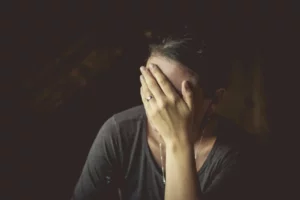Depression in Middle-Aged Women


Written and verified by the psychologist Andres Camilo Espinosa Poveda
Depressive disorders are a worldwide mental health problem. Their impact on well-being is extremely high and can become disabling. The mechanisms by which these disorders act explain, at least in part, the differences in incidence rates in the different social strata or groups.
In this article, we’ll look at how depression manifests itself, particularly in middle-aged women. Along the way, we’ll analyze its causes and precipitants, as well as the variables that increase women’s vulnerability to this disorder.
Biological causes of depression
Depressive disorders aren’t the product of a single cause, but of several interacting factors. We could say that the basis of this interaction is found in biological elements since these regulate and configure the adaptation of the organism.
On the one hand, the genetic factor is decisive. In fact, genetic predisposition explains about half of the cases of major depression and other depressive disorders. This means that an individual is more likely to suffer from one of these disorders if they’re a first-degree relative of an existing sufferer. Within the biological causes, an imbalance in neurotransmitters plays an important role. They alter the functioning of the brain and negatively impact moods.
Of course, these are factors to which we’re all exposed. However, women face other biological variables in addition to those already described. Indeed, throughout their life cycle, women experience important hormonal changes. Although in most cases these are assimilated without complications, they can sometimes trigger depressive states.
Puberty, menarche (first period), pregnancy, and menopause are all significant moments in a woman’s life. Important hormonal changes occur in the midst of these stages. Nevertheless, as we mentioned earlier, women usually manage to adapt without lasting effects. The difficulties come when the hormonal change is linked to another factor, such as a genetic predisposition.

Social causes of depression in middle-aged women
Social causes contribute the most significant factors to the risk of depression in middle-aged women. In fact, it’s society and stereotypes that increase women’s risk of developing mood disorders such as depression.
Limited access to jobs and educational opportunities can cause frustration in women’s lives. Indeed, in middle age, a woman might sadly recognize that, despite her efforts and dedication, she’s been unable to access a certain role or position, despite deserving it.
Also, at this stage, women might experience the consequences of decisions they made in their youth when they were pressured by stereotypes and gender roles. For example, choosing a career or leaving their profession to dedicate themselves to the home. Being aware of such circumstances can cause deep sadness and feelings of helplessness, with the potential to develop into more serious disorders.
Gender roles also give women the responsibility of managing the home and caring for children. This is associated with an additional workload that, if poorly managed, negatively affects their mental health.
In addition to the above, there are certain forms of violence in society that specifically affect women. Femicides, sexual violence, and domestic violence are serious phenomena in themselves. Furthermore, they have damaging effects on both the victims and their families, including the development of depressive disorders.
Individual causes of depression
In addition to all of the above, middle-aged women have personal characteristics that can act as risk factors.
At this stage of life, they may have endured sustained psychological pressure for several years. In fact, many women endure negative feelings, stress, and worries for years in areas like work, family, social, and financial. In middle age, the risk that these kinds of pressures reach a limit and end up generating symptoms of depression increases.
It’s also at this age that women may face the consequences of poor coping strategies. For instance, their lack of support networks and use of avoidance strategies like substance use, or denial of their own symptoms so as not to worry loved ones, increase the severity of existing risk factors.
Many women are seen as emotional support for their families and friends, so they’re used to giving help, but not asking for it. This means that, when they reach middle age, they don’t know how to seek help, and may even feel that doing so means they’re weak or they’ve failed.
Fighting depression
Knowledge is power. Now that we know the factors that expose women to depression during midlife, we can take action to prevent and treat it.
Health check-ups are a useful tool to identify risk factors and prevent multiple disorders. The mere fact of enjoying a good general state of health works as a protective factor for mental health. In addition, if there’s a genetic predisposition toward depressive disorders, it’s a good idea to have regular medical check-ups by a mental health professional.
Strengthening support networks can also be helpful. Although the ideal would be to build meaningful relationships as early as possible in life, it’s never too late to start. In fact, opening channels of communication and creating spaces to express emotions and concerns helps to reduce stress and emotional discomfort.
At the social level, although the current progress made in the search for gender equality can’t be denied, we still need to achieve more. That’s because gender inequality greatly contributes to the fact that depression is more frequent in women than in men. Therefore, dismantling stereotypes and unfair roles, such as those that put the responsibility of housework on women would be an invaluable contribution to reducing risks to their mental health.
Signs of depression
Although prevention should be the first objective, we must also be able to recognize the signs of risk and seek professional help when a depressive disorder already exists. Here are some of the symptoms:
- Sleep disturbances (sleeping too much or too little).
- Loss of interest in activities that are usually enjoyed.
- Impairment of interpersonal relationships.
- Frequent crying.
- Persistent and intense feelings of anguish.
- Feelings of tiredness that don’t go away.
We must remember that depression is a disease. Consequently, in the face of any symptom or alarm signal, it’s wise to seek professional help.

Take care of each other
The key to survival is not competition, but cooperation. Taking care of yourself is important, but so is taking care of others. Preventing and treating depression requires the support of loved ones.
If you’re a middle-aged woman experiencing symptoms of depression, don’t feel guilty about needing help; we all need it at different times. There’s a unique beauty at this stage of life and you deserve the space to discover it.
On the other hand, if you’re not a middle-aged woman, you might well know one who you want to take care of. Therefore, remember that being there for them, being willing to give them support, and building a healthier world together, will be invaluable.
Depressive disorders are a worldwide mental health problem. Their impact on well-being is extremely high and can become disabling. The mechanisms by which these disorders act explain, at least in part, the differences in incidence rates in the different social strata or groups.
In this article, we’ll look at how depression manifests itself, particularly in middle-aged women. Along the way, we’ll analyze its causes and precipitants, as well as the variables that increase women’s vulnerability to this disorder.
Biological causes of depression
Depressive disorders aren’t the product of a single cause, but of several interacting factors. We could say that the basis of this interaction is found in biological elements since these regulate and configure the adaptation of the organism.
On the one hand, the genetic factor is decisive. In fact, genetic predisposition explains about half of the cases of major depression and other depressive disorders. This means that an individual is more likely to suffer from one of these disorders if they’re a first-degree relative of an existing sufferer. Within the biological causes, an imbalance in neurotransmitters plays an important role. They alter the functioning of the brain and negatively impact moods.
Of course, these are factors to which we’re all exposed. However, women face other biological variables in addition to those already described. Indeed, throughout their life cycle, women experience important hormonal changes. Although in most cases these are assimilated without complications, they can sometimes trigger depressive states.
Puberty, menarche (first period), pregnancy, and menopause are all significant moments in a woman’s life. Important hormonal changes occur in the midst of these stages. Nevertheless, as we mentioned earlier, women usually manage to adapt without lasting effects. The difficulties come when the hormonal change is linked to another factor, such as a genetic predisposition.

Social causes of depression in middle-aged women
Social causes contribute the most significant factors to the risk of depression in middle-aged women. In fact, it’s society and stereotypes that increase women’s risk of developing mood disorders such as depression.
Limited access to jobs and educational opportunities can cause frustration in women’s lives. Indeed, in middle age, a woman might sadly recognize that, despite her efforts and dedication, she’s been unable to access a certain role or position, despite deserving it.
Also, at this stage, women might experience the consequences of decisions they made in their youth when they were pressured by stereotypes and gender roles. For example, choosing a career or leaving their profession to dedicate themselves to the home. Being aware of such circumstances can cause deep sadness and feelings of helplessness, with the potential to develop into more serious disorders.
Gender roles also give women the responsibility of managing the home and caring for children. This is associated with an additional workload that, if poorly managed, negatively affects their mental health.
In addition to the above, there are certain forms of violence in society that specifically affect women. Femicides, sexual violence, and domestic violence are serious phenomena in themselves. Furthermore, they have damaging effects on both the victims and their families, including the development of depressive disorders.
Individual causes of depression
In addition to all of the above, middle-aged women have personal characteristics that can act as risk factors.
At this stage of life, they may have endured sustained psychological pressure for several years. In fact, many women endure negative feelings, stress, and worries for years in areas like work, family, social, and financial. In middle age, the risk that these kinds of pressures reach a limit and end up generating symptoms of depression increases.
It’s also at this age that women may face the consequences of poor coping strategies. For instance, their lack of support networks and use of avoidance strategies like substance use, or denial of their own symptoms so as not to worry loved ones, increase the severity of existing risk factors.
Many women are seen as emotional support for their families and friends, so they’re used to giving help, but not asking for it. This means that, when they reach middle age, they don’t know how to seek help, and may even feel that doing so means they’re weak or they’ve failed.
Fighting depression
Knowledge is power. Now that we know the factors that expose women to depression during midlife, we can take action to prevent and treat it.
Health check-ups are a useful tool to identify risk factors and prevent multiple disorders. The mere fact of enjoying a good general state of health works as a protective factor for mental health. In addition, if there’s a genetic predisposition toward depressive disorders, it’s a good idea to have regular medical check-ups by a mental health professional.
Strengthening support networks can also be helpful. Although the ideal would be to build meaningful relationships as early as possible in life, it’s never too late to start. In fact, opening channels of communication and creating spaces to express emotions and concerns helps to reduce stress and emotional discomfort.
At the social level, although the current progress made in the search for gender equality can’t be denied, we still need to achieve more. That’s because gender inequality greatly contributes to the fact that depression is more frequent in women than in men. Therefore, dismantling stereotypes and unfair roles, such as those that put the responsibility of housework on women would be an invaluable contribution to reducing risks to their mental health.
Signs of depression
Although prevention should be the first objective, we must also be able to recognize the signs of risk and seek professional help when a depressive disorder already exists. Here are some of the symptoms:
- Sleep disturbances (sleeping too much or too little).
- Loss of interest in activities that are usually enjoyed.
- Impairment of interpersonal relationships.
- Frequent crying.
- Persistent and intense feelings of anguish.
- Feelings of tiredness that don’t go away.
We must remember that depression is a disease. Consequently, in the face of any symptom or alarm signal, it’s wise to seek professional help.

Take care of each other
The key to survival is not competition, but cooperation. Taking care of yourself is important, but so is taking care of others. Preventing and treating depression requires the support of loved ones.
If you’re a middle-aged woman experiencing symptoms of depression, don’t feel guilty about needing help; we all need it at different times. There’s a unique beauty at this stage of life and you deserve the space to discover it.
On the other hand, if you’re not a middle-aged woman, you might well know one who you want to take care of. Therefore, remember that being there for them, being willing to give them support, and building a healthier world together, will be invaluable.
All cited sources were thoroughly reviewed by our team to ensure their quality, reliability, currency, and validity. The bibliography of this article was considered reliable and of academic or scientific accuracy.
- Álvaro-Estramiana, J. L., Garrido-Luque, A., & Schweiger-Gallo, I. (2010). Causas sociales de la depresión. Una revisión crítica del modelo atributivo de la depresión. Revista internacional de sociología, 68(2), 333-348.
- Dio Bleichmar, E. (1992). La depresión en la mujer. Revista de la Asociación Española de Neuropsiquiatría., 11(39), 283-289.
- Gómez, C. O., Agudelo, A. F. C., & Carmona, N. D. M. (2015). Depresión en la mujer:¿ expresión de la realidad actual?. Revista Colombiana de Ciencias Sociales, 6(1), 113-135.
This text is provided for informational purposes only and does not replace consultation with a professional. If in doubt, consult your specialist.







